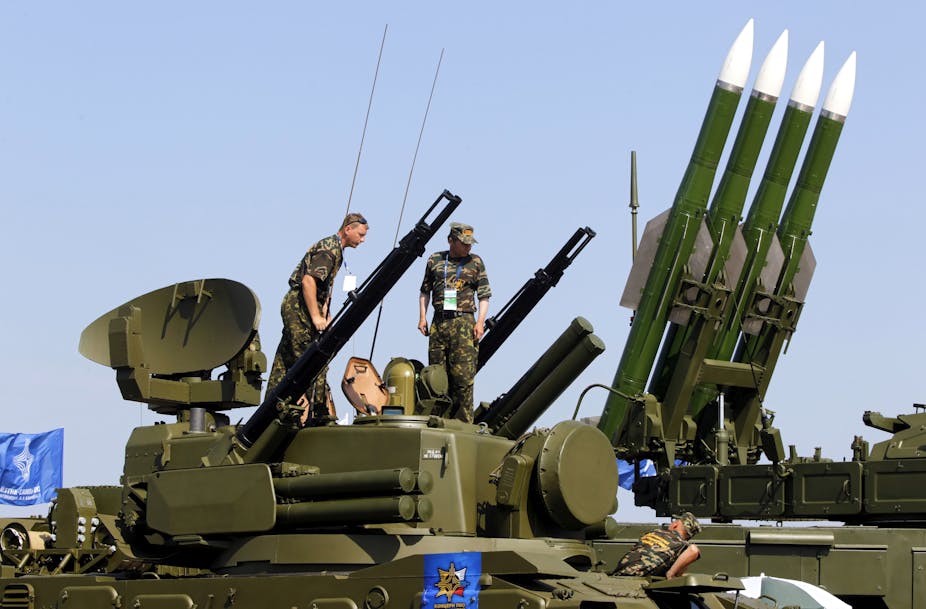On July 17 2014, a Malaysia Airlines flight out of Amsterdam (MH17) was shot down over the disputed region of Eastern Ukraine, near Luhansk in the Donetsk region, relatively near the Russian border.
The Russian government immediately came out to blame the Ukrainian state forces for starting the war that led to this tragedy. The United States, relying on the time zone differences, stated they had intelligence detailing the time, place, heat signature and radar lock as the plane flew over the disputed region.
Debates about weapons are short-lived, as evidence suggests rebel forces have BUK surface-to-air missile (SAM) systems, as do the Russian and Ukrainian forces. Debates about the intention, however, will be much more difficult to determine.
Pro-Russian rebel forces have shot down numerous Ukrainian military aircraft in the past month while more recently it appears that a Russian fighter jet shot down a like Ukrainian SU-25 attack jet on July 16.
So, we have capabilities and a pattern of bringing down military aircraft, but we still do not know the intentions of those who shot down the Malaysia Airlines plane. Two pieces of evidence point in the direction of culpability at the pro-Russian rebel forces. The first is the screen shot of a rebel web page detailing the shooting down of what was thought to be a Ukrainian transport plane (now deleted). The second piece of evidence is the tapped phone conversations that appear to celebrate and then turn to shock as details of what has happened come in.
Command and control
The problem for analysis is understanding the nature of command and control, known as C2 in the military. C2 allows for co-ordinated and sustained operations, in large operations with executive decisions taken by a division or above commanding officer.
What has been the state of C2 in the pro-Russian forces? Pro-Russian separatist forces have several characteristics in this case. The first is that they are themselves self-constituted militias. In other words, they are relatively new and lack a prolonged sense of institutional structures or standard operating procedures (SOPs). The second is that they are also constituted of defected Ukrainian soldiers and officers as well as mercenaries from the former Soviet Union bought primarily from other parts of Ukraine and the Russian Federation.
More debatable, though with increasing evidence to support it, is that there are Russian special operations forces (Spetsnaz, derived from Voyska spetsialnogo naznacheniya,) supporting the pro-Russian forces. The presence of Spetsnaz forces in Ukraine would surely increase the professionalism and C2 capabilities of the pro-Russian forces. At the same time, the intensity, sparse nature, and political nature of Russian special forces in Ukraine may have limited their impact.
Finally, the pro-Russian forces are not a single unit. While the militias in Luhansk and Donetsk do co-operate, command structures have developed organically rather than as a result of a pattern of training together within an organised military. As a result, the cohesion that makes effective C2 possible is likely to be underlined by the cause in the short term rather than the long-term perspective of the fighting force as a whole. All of this is to say that C2, and the intelligence that supports it, may have led to the downing of MH17.
Informed decision?
With respect to the pro-Russian forces, there is little evidence to suggest that rebel command and control is at a level that would have been able to make a better-informed decision about what sort of aircraft was being flown over the region. The fact the plane was travelling well above 10,000 meters (33,000 feet) would have suggested to military intelligence and thus a commanding officer that this is not a military aircraft.
The situation also points to training to use such equipment. Indeed, specific Ukrainian and Russian military forces would be able to use such assets, but a typical rebel more than likely would not. So, we have either former Ukrainian soldiers or, as are being argued by the United States, Russian Spetsnaz forces training or operating the SAMs.
In the end, let us assume that no one sought to bring down a Malaysia Airlines plane, which no doubt will be debated by some. Commercial flights fly over conflict zones all the time, but rarely with such consequences. The occasion points to a bigger problem as the lack of command and control has the potential to further increase the intensity of war rather than relieve it. Commanding prosecuting power is vital in war but controlling constraint is just as vital for its eventual end.

